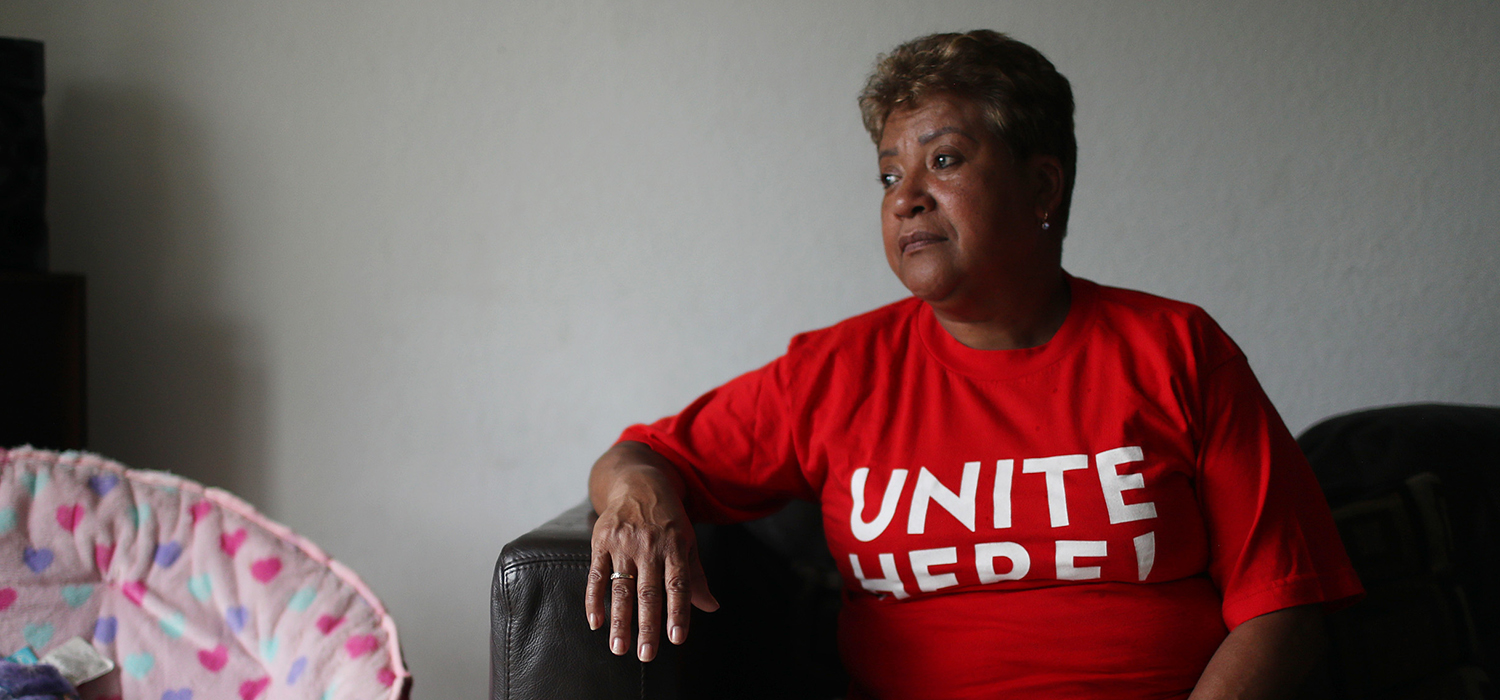
<p>Teresa Saenz, who worked at the Diplomat Hotel, poses for a picture in her home on June 4, 2020, in Hallandale Beach, Florida. Mrs. Saenz was laid off after the hotel closed amid COVID-19. Mrs. Saenz has been waiting for unemployment benefits and has yet to receive any, which is making it difficult for her to make ends meet. (Photo by Joe Raedle/Getty Images)</p>
As unemployment and economic hardship continue to increase during the COVID-19 pandemic, particularly for families of color, Congress is considering policies to further support households and stimulate the economy. Among the options on the table are a set of policies proposed in the Health and Economic Recovery Omnibus Emergency Solutions (HEROES) Act that would keep an estimated 12.2 million people out of poverty from August to December, according to a new Urban Institute report.
That set of policies include extending the additional $600 per week unemployment insurance benefits through January 2021, distributing and expanding eligibility for a second round of stimulus checks, and increasing Supplemental Nutrition Assistance Program (SNAP) benefits.
These policies are projected to reduce poverty across all racial and ethnic groups but would have the greatest antipoverty impact for Black and Hispanic people, especially those who lost a job because of COVID-19. In families where at least one person has lost a job, these policies would cut Black people’s projected poverty in half, falling from 20.4 percent to 10.1 percent in the last five months of 2020.
Urban’s analysis, using the Analysis of Transfers, Taxes, and Income Security microsimulation model, measures poverty by counting cash income, SNAP, and the proposed second round of stimulus checks in August through December as income and compares that with a fraction of the annual poverty level, considering the resources are received over five months instead of a full year.
Universal benefits for reducing poverty, with the greatest impact for Black and Hispanic people
Although the initial set of pandemic-response policies through the Coronavirus Aid, Relief, and Economic Security and Families First Coronavirus Response Acts significantly reduced the projected annual poverty rate, the benefit was short-lived. Many families may have already spent their stimulus checks, and the additional unemployment insurance benefits are set to expire at the end of the July.
The policies proposed in the HEROES Act would result in significantly lower projected poverty across racial and ethnic groups than if no new policies were enacted, highlighting the potential of these policies to improve economic conditions for a wide array of people.

Although the effects are similar, some groups receive a greater benefit; poverty in August to December would be reduced by an estimated 32 percent for Black people and by 36 percent for Hispanic people, which translates to more than 2.3 million Black people and 3.7 million Hispanic people being raised above the federal poverty line by these provisions.
But even under the modeled policy change, Black and Hispanic people are still estimated to have the highest rates of poverty relative to other racial and ethnic groups (13 and 11 percent, respectively).
More than 4 million people who have lost jobs could be kept out of poverty with expanded benefits
At the peak of the job loss following nationwide shutdowns in late March and April, more than 23 million people had lost their jobs. Even though the unemployment rate has since decreased nationally and for all reported racial and ethnic groups, more than 17 million people are still unemployed.
Black and Hispanic households continue to experience disproportionate effects, with 56 percent and 61 percent of adults reporting in late June that someone in their household had lost employment income since March 13, compared with 44 percent of white households.

For households with COVID-19-related job loss, the three HEROES Act policies modeled here would reduce the projected August–December poverty rate by 43 percent and the number of people who would may have otherwise been in poverty by 4.5 million.
One in five Black and Hispanic people are at risk of being in poverty later this year
Absent new legislation, more than 20 percent of Black and Hispanic people in households where job loss occurred are predicted to be in poverty from August until the end of the year. If the three HEROES Act policies are enacted, the predicted poverty rate would be cut by half for Black people and by more than 40 percent for all other groups.
That the impact is larger for Black and Hispanic people than for white people in households with job loss is further evidence of the financially tenuous position for many people of color. As of 2018, the Black median income of $41,511 was only two-thirds of the national median income. And in the event of a job loss, Black and Hispanic families have much less financial cushion, with only one-tenth and one-eighth the wealth of white households.
In the absence of policy action, this poverty rate increase likely translates to people being unable to pay their rent, buy sufficient food for their families, and stay on top of other bills (PDF). And given the existing structural inequalities that lead to Black and Hispanic people working in lower-paying jobs and having less wealth, inaction may only exacerbate racial inequities if families get evicted and fall into debt and food insecurity.
As the country continues to grapple with the COVID-19 crisis, legislators should consider policies that provide much-needed aid to all families but that also target support to Black and Hispanic communities who have been disproportionately hurt by job loss and are at greater risk of poverty as a result of the pandemic.
Let’s build a future where everyone, everywhere has the opportunity and power to thrive
Urban is more determined than ever to partner with changemakers to unlock opportunities that give people across the country a fair shot at reaching their fullest potential. Invest in Urban to power this type of work.